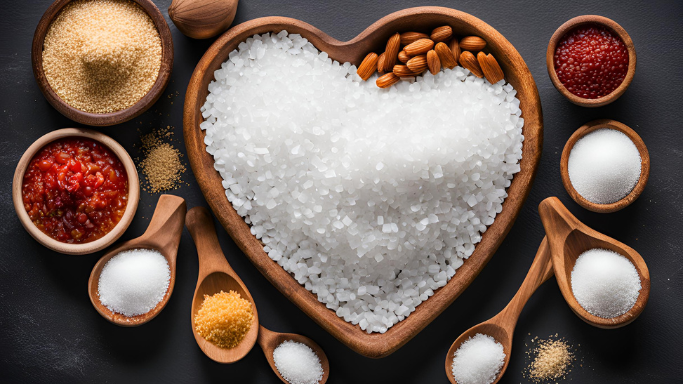Salt, or sodium chloride, is a necessary mineral for the body. It helps maintain fluid balance, supports nerve function, and aids in muscle contraction. However, excessive salt intake can contribute to serious health conditions, particularly high blood pressure, heart disease, and stroke. Understanding how much salt you should eat per day and how to monitor your intake is important for maintaining overall health.
1. Recommended Daily Salt Intake
Health organizations around the world have established guidelines for how much salt is safe for daily consumption. According to the World Health Organization (WHO), the ideal daily intake of sodium should be less than 2,000 milligrams (mg), which is roughly equivalent to 5 grams (g) of salt (about one teaspoon). This is the amount that most adults should aim to consume for optimal health.
In the United States, the Dietary Guidelines for Americans (DGA) recommend a daily sodium intake of less than 2,300 mg (approximately 1 teaspoon of salt) for healthy adults. However, the American Heart Association (AHA) suggests an even lower target of 1,500 mg per day, especially for individuals with risk factors for heart disease, including those with high blood pressure, diabetes, or kidney disease.
Despite these recommendations, most people consume much more salt than is considered healthy. The average American consumes about 3,400 mg of sodium per day, which exceeds both the WHO and DGA guidelines. This excess salt typically comes from processed foods, restaurant meals, and packaged snacks.
2. The Risks of Too Much Salt
While sodium is vital for bodily functions, too much can have negative effects. High sodium intake can lead to:
High Blood Pressure (Hypertension): The most well-known consequence of excessive salt consumption is its role in raising blood pressure. High blood pressure is a major risk factor for cardiovascular diseases, including heart attack, stroke, and kidney disease. When you eat too much salt, the body retains water to balance sodium levels, which increases the volume of blood in the circulatory system and raises blood pressure.
Heart Disease and Stroke: Over time, the strain caused by high blood pressure can damage blood vessels, increasing the risk of heart disease and stroke. Consistently consuming too much sodium has also been linked to an increased risk of heart failure and other cardiovascular conditions.
Kidney Disease: The kidneys are responsible for filtering excess sodium out of the bloodstream. When the body is overwhelmed with too much salt, it can lead to kidney damage and kidney disease over time.
Bone Health: A high-salt diet can also lead to calcium loss in the urine, which may increase the risk of osteoporosis and fractures in the long term.
3. Sources of Excess Salt in the Diet
The majority of our salt intake comes from processed and packaged foods, rather than from what we add at the table. Common sources of excess sodium include:
Processed Foods: Items like canned soups, frozen meals, fast food, and snacks are often high in sodium. Even foods that don’t taste particularly salty, like bread or cereal, can contribute significant amounts of sodium.
Restaurant Meals: Restaurant food, especially fast food and takeout, can contain much higher levels of salt than home-cooked meals. Sauces, dressings, and marinades often add hidden sodium.
Condiments and Sauces: Items such as soy sauce, ketchup, and salad dressings are often packed with sodium. A tablespoon of soy sauce, for example, contains over 1,000 mg of sodium.
Cured and Processed Meats: Bacon, ham, sausage, and deli meats are also high in sodium due to the curing and preservation process.
4. How to Reduce Salt Intake
While it may seem difficult to reduce sodium consumption, there are several practical strategies that can help:
Cook at Home: Preparing meals from scratch allows you to control the amount of salt added. Use herbs, spices, and other flavorings like lemon, vinegar, or garlic to season food instead of salt.
Read Labels: When buying packaged foods, check nutrition labels for sodium content. Look for low-sodium or no-salt-added options when possible.
Limit Processed Foods: Reduce consumption of processed snacks, frozen meals, and fast food, which are often loaded with sodium.
Choose Fresh Ingredients: Fresh fruits, vegetables, meats, and fish naturally contain little to no sodium, making them healthier choices.
Use Salt Alternatives: If you're looking to add flavor without sodium, consider using potassium chloride-based salt substitutes, or opt for sodium-free seasonings.
5.Special Considerations
Children and Sodium: Children are more sensitive to the effects of high sodium intake, so it's especially important to ensure they consume salt within recommended guidelines. The American Heart Association recommends children aged 1-3 years limit their sodium intake to 1,500 mg per day, and children aged 4-8 years to 1,900 mg.
Health Conditions: If you have certain health conditions like hypertension, kidney disease, or heart disease, your doctor may recommend even stricter limits on your sodium intake. It's always important to follow medical advice tailored to your specific needs.
Conclusion
Salt is an essential mineral that plays a critical role in maintaining fluid balance and supporting bodily functions. However, consuming too much salt can have serious health consequences, particularly for cardiovascular and kidney health. By adhering to recommended guidelines, reducing processed food intake, and being mindful of sodium levels in your diet, you can better manage your salt consumption for long-term health. Always aim for balance and consult your healthcare provider if you have any concerns about your sodium intake.




